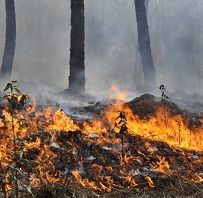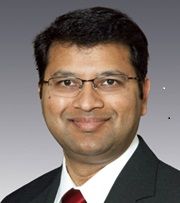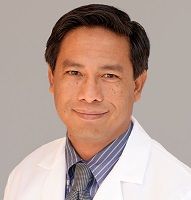Pulmonology Crisis: Wildfires Have the West Wheezing
Firefighters aren't the only heroes coping with wildfires in the Western US. The record-setting blazes are sending droves of patients with breathing problems to hospitals and clinics seeking help from pulmonologists.

Last year Vipul Jain, MD, a University of California San Francisco pulmonologist was proudly recounting the successes of his program to curb emergency visits and hospitalizations for patients with chronic obstructive pulmonary disease (COPD). His study was published Sept. 28, 2014 in Respiratory Medicine. “ER visits were down by 75% and hospitalizations by 60%,” Jain (photo at right) said in an interview.

Those numbers are now going up in smoke.
Record drought in the Western US that has contributed to an explosive wildfire season is sending droves of wheezing, coughing patients to physicians and asthma clinics. Jain’s patients’ ER visits and hospitalizations are rising again, up from 20% to 50%, he said.
With 545,000 acres in California burned or burning, smoke is spreading throughout the state and beyond. “You can tell just by looking that the air is bad,” said Jain, whose practice is about 250 miles from the latest fires, “You can’t see a single star at night.”
The smoke from wildfires can contain particulate matter, polynuclear aromatic hydrocarbons, aldehydes, carbon monoxide and other irritants. It travels hundreds of miles. With no rain to clear it, the smoke has asthma patients gasping, and even those who do not have chronic breathing problems are suffering, physicians there report.
“Patients feel it coming, typically patients with COPD and asthma,” Jain said, “They get coughing spasms because their lungs are trying to expel the irritants.” Devices with HEPA filters are in demand, he said, and seem to help. “I tell patients to stay indoors, use their inhalers, and close the windows at night.”
The Fresno area is geographically prone to smog, he said. “It’s the perfect storm—stagnant air and no ventilation to clear it out.”
Earlier in the summer, Jain said, smoke from the fires turned the rising full moon an ominous looking deep red. “It looked like a burning moon,” he said. Patients are suffering.
“There’s just not that much you do—we bump up their meds, and tell them to avoid triggers,” Jain said.
Some schools in central California have had to close due to the air pollution.

In Bakersfield, Thu Yein, MD, a pulmonologist and specialist in critical care medicine at Kaiser Health affiliate San Joaquin Community Hospital, said his practice is also feeling the effects. “It’s usually within three weeks of a forest fire,” Yein (photo at left) said, “It happens every year.”
In the San Joaquin Valley, “Everything sticks and there’s no wind to blow it out,” he said, “When I see that dust I know we are going to be busy.”
Adding to the forest fire smoke, there is the annual almond harvest. Farmers use vehicles with giant robotic arms that grab the trees by the trunk and rattle them until clouds of almonds, dust, and husk particles rain down. A harvester picks them up, but that process results in soil, leaves, and other orchard debris filling the air. This “orchard dust” particulate matter gets picked up by the wind adding to air quality problems, according to the University of California’s agriculture school.
It’s one more problem for pulmonologists, said Yein.
Smoke has been a problem in Washington State, where residents are urged to monitor wildfire and smoke conditions daily at http://wasmoke.blogspot.com/.
In Denver, Co., forest fire smoke has drifted down from Canada and Washington. According to local news reports, it is expected to be a continuing problem, though today’s forecast predicts a cold front could help.
At National Jewish Health, a renowned health system and Denver hospital specializing in pulmonology, the pollution has been hard on children with breathing problems who are among the pupils at the Morgridge Academy, a school for the chronically ill on the hospital’s campus. “A handful of children missed school, several were given extra medications and one went to the emergency room,” a health system spokesman said. “The children had physical education classes inside for several days,” he added. A local tv station reported the problem.
Daily updates on fire-related air quality are posted on a state website. Public health advisories include closing windows at night, and avoiding other sources of secondhand smoke, including from candles.
In Fresno, Jain said the bad air quality is a chronic problem, and, like Yein looked forward to some respite when El Nino winds and rains begin in a few months—if that doesn’t bring disastrous flooding as some have predicted.
For now, there is no immediate sign of rain, he said.